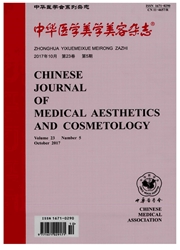

 中文摘要:
中文摘要:
目的 探讨人毛乳头细胞(human dermal papilla cells,HDPCs)经过体外长期的传代培养后,其与诱导毛囊生成能力相关的细胞特异性标记物的表达.方法 使用一步酶消化法将人毛乳头分离后,在体外进行HDPCs传代培养,取第1~8代HDPCs,在倒置显微镜下观察不同传代时期的生长情况;使用碱性磷酸酶(alkaline phosphatase,ALP)染色方法和实时定量基因扩增荧光检测系统(real-time quantitative PCR detecting system,QPCR),检测第1~8代HDPCs在不同传代时期其特异性标记物ALP和胰岛素样生长因子-1(insulin like growth factor-1,IGF-1)的表达.结果 HDPCs在体外传代培养过程中,不但逐渐丧失其聚集性、旋涡状生长的特性,而且ALP和IGF-1表达水平逐渐下降.第1代HDPCs的ALP和IGF-1表达水平分别是第8代的6.8倍和3.5倍.第1代和第2代HDPCs的ALP染色表达较明显,但是随着传代代数的增加,阳性表达的细胞逐渐变少,并且染色逐渐变浅.结论 HDPCs经过体外长期的传代培养后,其与诱导毛囊生成能力相关的特异性标记物ALP和IGF-1的表达水平逐渐下降,HDPCs失去聚集性、旋涡状生长的特性,从而导致高传代的HDPCs丧失诱导毛囊生长的能力.
 英文摘要:
英文摘要:
Objective To investigate the expression of specific marker molecules in hair-inducing activity of long-term cultured human dermal papilla cells (HDPCs) in vitro.Methods After dissected and cultured the HDPCs in vitro,the cells of passages 1 to 8 were used for experiments.The growth appearances of HDPCs in different passages were observed under inverted microscope.To detect the expression of specific marker molecules of long-term cultured HDPCs,the alkaline phosphatase (ALP) activity of the HDPCs was examined,and the specific genes ALP and insulin-like growth factor-1 (IGF-1) expression levels of HDPCs were determined by real-time quantitative PCR.Results After long-term cultured in vitro,the ALP and IGF-1 expression levels of HDPCs gradually decreased in different passages,as well as the display of the aggregated and cartouche growth.The ALP and IGF-1 expression levels of HDPCs in passage 1 was the highest,they were almost about 6.8-fold and 3.5-fold higher than the HDPCs in passage 8.The ALP staining of the HDPCs in passage 1 and passage 2 were evident,but the cells' ALP staining gradually became much weaker than the cells in the previous passages after the long-term cultured in vitro.Conclusions The expression levels of specific marker molecules ALP and IGF-1 of the HDPCs decrease gradually after long-term cultured in vitro,and the higher passage HDPCs lost the special aggregated and cartouche growth appearance,and hence lead to the loss of hair-inducing activity of HDPCs.
 同期刊论文项目
同期刊论文项目
 同项目期刊论文
同项目期刊论文
 Construction and expression of retroviral vector pLEGFP-N1-TERT in preparation of seed cells for ski
Construction and expression of retroviral vector pLEGFP-N1-TERT in preparation of seed cells for ski Neonatal murine skin-derived cells transplanted using a mini-chamber model produce robust and normal
Neonatal murine skin-derived cells transplanted using a mini-chamber model produce robust and normal Controllable Production of Transplantable Adult Human High-Passage Dermal Papilla Spheroids Using 3D
Controllable Production of Transplantable Adult Human High-Passage Dermal Papilla Spheroids Using 3D 期刊信息
期刊信息
